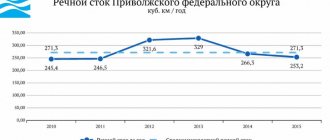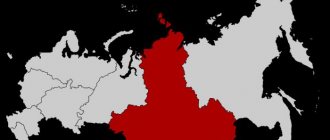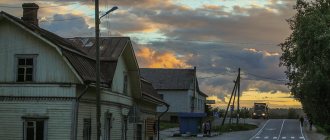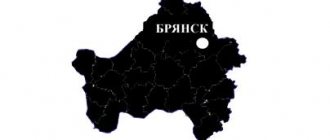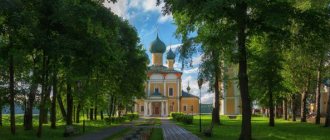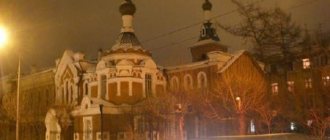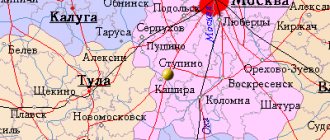Volga Federal District
(PFD) is a federal district of the Russian Federation, formed by the Decree of the President of the Russian Federation of May 13, 2000.
The district includes 14 constituent entities of the Russian Federation.
The territory of the district makes up 6.06% of the territory of the Russian Federation. The district has no access to the World Ocean.
The population of the Volga Federal District is 29,087,997 people. (2021) (19.89% of the Russian population). The bulk of the population consists of city dwellers (72.69%), which is generally slightly lower than the all-Russian figure (74.92%).
The administrative center is Nizhny Novgorod, the largest city of the district is Kazan.
The share of industrial production in the Volga Federal District in the Russian economy is 23.9% - this is the highest figure (the Central Federal District is in second place). The share of the Volga Federal District in the total volume of agricultural production of all agricultural producers in Russia in the second quarter of 2005 was 24.7%. The volume of investments in the Volga Federal District is 15.3% of all investments in Russia.
The Volga Federal District and the Volga region are different concepts. Thus, part of the Lower Volga (Volgograd and Astrakhan regions) belongs to the Southern Federal District, while the Volga Federal District also includes subjects geographically located in the Urals and the Urals (Bashkortostan, Udmurtia, Perm Territory, Orenburg and Kirov regions).
Population
The population of the district according to Rosstat is 29,087,997 people. (2021). Population density - 28.05 people/km2 (2021). Urban population - 72.69% (2020).
National composition
Ethnic cards
Languages
The following groups and families predominate in terms of ethno-linguistic composition:
- Indo-European family - 20,438,608 people. (68.36%)
- Slavic group - 20,155,068 (67.41%)
- Armenian group - 108,777 (0.36%)
- Iranian group - 49,899 (0.17%)
- German group - 48,509 (0.16%)
- Indo-Aryan group - 28,761 (0.10%)
- Jews (Yiddish) - 20,968 (0.07%)
- Roman group - 16,464 (0.06%)
- Altai family - 6,932,428 (23.19%)
- Turkic group - 6,930,981 (23.18%)
- Ural family - 1,678,504 (5.61%)
- Finno-Ugric group - 1,678,377 (5.61%)
- North Caucasian family - 41,827 (0.14%)
- Dagestan group - 25,438 (0.09%)
- Nakh group - 13,980 (0.05%)
- Kartvelian family - 13,542 (0.05%)
- Koreans - 12,215 (0.04%)
- Austroasiatic family - 2,915 (0.01%)
The Volga Federal District ( VFD includes 15 constituent entities of the Russian Federation: the republics of Bashkortostan, Mari El, Mordovia, Tatarstan, Udmurtia, Chuvashia; Kirov, Nizhny Novgorod, Orenburg, Penza, Perm, Samara, Saratov, Ulyanovsk regions; Komi-Permyak Autonomous Okrug. The center of the district is the city of Nizhny Novgorod.
The Volga Federal District occupies 1038 thousand square meters. km.
The population of the region is 32,019 thousand people. The share of urban residents is 70.8%. The district contains five largest Russian cities with a population of more than 1 million: Nizhny Novgorod, Samara, Kazan, Ufa, Perm. Volga Federal District is one of the most multinational districts. It is home to Russians, Tatars, Bashkirs, Chuvashs, Udmurts, Mordovians, Maris, Komi-Permyaks - in total about 140 representatives of various nations, nationalities, and ethnic groups. 179 national and cultural autonomies are registered.
The region is rich in a variety of mineral resources. In addition to oil and gas reserves, which account for 13 and 2% of the total Russian reserves, respectively, unique reserves of potassium salts are concentrated here (about 96% of all explored resources of the country), large resources of phosphorites - 60%, zinc - 19%, copper - 16%, cement raw materials - 15%, silver - 14%, gold - 7%, mineral waters - 7%. The Volga Federal District has small deposits of nickel, chromium, lead, iron ores, titanium, alluvial diamonds, coal, as well as huge reserves of various raw materials for the production of building materials. Fuel resources are represented by oil, natural gas, oil shale, and peat.
The Volga Federal District is one of the leading in the country in terms of industrial development and one of the main agricultural regions of Russia, producing about 27% of agricultural products. A characteristic feature of the Volga region is a large proportion of enterprises of the military-industrial complex.
The most important industries in the region are the diversified, highly developed mechanical engineering and petrochemical complex. Mechanical engineering is represented in the district: transport - automotive, shipbuilding, aviation; precision and complex - instrument making, electrical engineering industry, electronic engineering, as well as machine tool building and tool industry, production of technological equipment for the petrochemical complex, tractor manufacturing and others.
There are 13 State Nature Reserves in the district:
Basegi, Reserve Bashkir Reserve Bolshaya Kokshaga Reserve Vishera Reserve Volga-Kama Reserve Zhigulevsky Kerzhensky Reserve Mordovian Reserve Nurgush Reserve Orenburg Reserve Volga forest-steppe Prisursky Reserve Shulgan-Tash Reserve
There are also 9 National Parks in the district: Bashkiria, Buzuluksky Bor National Park Mari Chodra National Park Nechkinsky National Nizhnyaya Kama National Park Samarskaya Luka National Smolny National Park Khvalynsky National Park Chavash Varmane National Park
There are also federal reserves in the district: Volga State Experimental Hunting Estate Zubovo-Polyansky State Experimental Hunting Estate Penza State Experimental Hunting Estate
***
Volga Federal District
- Nizhny Novgorod Region
- Republic of Bashkortostan
- Kirov region
- Mari El Republic
- The Republic of Mordovia
- Orenburg region
- Penza region
- Perm region
- Samara Region
- Saratov region
- Republic of Tatarstan
- Udmurt republic
- Ulyanovsk region
- Chuvash Republic
Territory:
The Volga Federal District occupies 6.1% of Russia's territory - it is the second most populous federal district after the Central. It includes 14 regions: 6 republics (Bashkortostan, Mari-El, Mordovia, Tatarstan, Udmurtia, Chuvashia), Perm Territory and 7 regions (Kirov, Nizhny Novgorod, Orenburg, Penza, Samara, Saratov, Ulyanovsk). The center of the Volga Federal District is the city of Nizhny Novgorod.
Population:
The territory of the Volga Federal District is inhabited by Russians (more than 70%), Tatars, Bashkirs, Chuvashs, Udmurts, Mordovians, Maris, Komi-Permyaks, as well as representatives of other nations, nationalities and ethnic groups.
The majority of the district's population is Orthodox (approximately 70-75%); more than 20% profess Islam. At the same time, citizens of the Muslim faith make up about 40% of adherents of this denomination in Russia. The main scientific and theological institutes, spiritual administrations and places of mass religious worship of Muslims are concentrated in the republics of Tatarstan and Bashkortostan. However, there are religious and administrative Muslim units (muftiates, mosques, houses of worship and individual representatives of this faith - missionaries) in almost all regions of the district.
Also in the territory of the district, representatives of Judaism (operating synagogues in Perm, Samara, Ufa, Nizhny Novgorod), Catholicism (Perm, Ufa), Lutheranism (Perm, Saratov) and some other denominations (for example, Baptists, as well as operating in the southern regions of the Volga region Gregorian - “Armenian” church).
With the development of the democratic foundations of the state's social structure, in some regions such religious movements and national beliefs as paganism (Mari El, Mordovia, Perm Territory), Old Believers (Perm Territory, Nizhny Novgorod and Kirov regions) are being revived.
Production potential:
A special feature of the district is the presence of significant production potential. A quarter of all industrial production in Russia, 85% of the Russian automobile industry, 65% of aircraft manufacturing, 40% of petrochemicals, 30% of shipbuilding, 30% of the production of the military-industrial complex are concentrated here. A distinctive characteristic of the structure of the gross regional product of the Volga Federal District is the high share of manufacturing industries - 24.5% (in Russia - 19.3%), as well as mining - 13.7% (in Russia - 10.5%).
In assessing the total investment potential of the constituent entities of the Russian Federation, 5 regions of the district are among the leaders (Republic of Bashkortostan, Republic of Tatarstan, Perm Territory, Nizhny Novgorod and Samara regions), demonstrating high performance in production, financial, innovation, natural resource and consumer factors of investment assessment.
The traditional specialization of the district is mechanical engineering. Enterprises located in the regions make the largest contribution among federal districts to the added value produced in this industry (more than 33% of the all-Russian figure). More than 73% of cars (for trucks this figure exceeds 90%), more than 85% of buses, and more than 80% of car engines are produced in the Volga region. This industry is represented by the largest enterprises in the country: Volzhsky, Gorky, Kama, Ulyanovsk and other automobile plants.
In many regions of the district, aviation, rocket and space and power engineering, shipbuilding, instrument making, and machine tool manufacturing are widely developed. The district is a leader in the production of mineral fertilizers, synthetic resins and plastics, tires, and caustic soda. The multifunctional agro-industrial complex of the Volga Federal District provides a quarter of Russia's agricultural products and a third of grain volumes.
The Volga region is in second place after the Ural Federal District in oil production (the regions account for about 20% of Russian production) and natural gas (production is concentrated in the Orenburg region).
Transit position:
The Volga region has a unique transit position, as it is located at the crossroads of the international transport corridors “North-South” and “East-West”, connecting Siberia and the Far East, as well as the countries of East Asia with European Russia and European countries. The competitive advantages of the geographical location of the district also include the presence of convenient access to Western Kazakhstan, Uzbekistan, and Tajikistan.
Most of the pipelines from Western Siberia pass through the territory of the Volga Federal District, which contributes to the development of the chemical industry and reduces the costs of providing the regions with fuel resources, including gas. The country's largest coal flows pass through the district in transit - from Kuzbass to the northwestern and Black Sea ports.
The district has a fairly high level of development of transport infrastructure. In terms of railway density, the district ranks third in the Russian Federation (143 km of tracks per 10 thousand sq. km of territory) after the Center and the South. The district ranks 2nd in Russia in terms of road density (140 km of roads per 1000 sq. km of territory).
Volga Federal District (VFD) on the map:
When writing the material, information was used from the official website of the Plenipotentiary Representative of the President of the Russian Federation in the Volga Federal District: https://www.pfo.ru
Region/Province/City
The Nizhny Novgorod region is one of the largest regions of the Russian Federation in the center of the European part of the country. Area – 76,900 km2, population – 3,202,946 (2021 data). It is part of the Volga Federal District. The Nizhny Novgorod region is one of the most economically developed regions of the Russian Federation. The share of the Nizhny Novgorod region in the formation of the total GRP of the regions of the Russian Federation is 1.7%. The Nizhny Novgorod region is one of the largest industrial centers in Russia with a high share of industry in the economy. The main industries are mechanical engineering, chemistry, ferrous metallurgy, forestry, pulp and paper, light industry, food. In terms of the volume of manufactured products shipped by processing enterprises, the region is confidently among the top ten Russian regions. The region has a unique scientific and technical potential combined with a strong educational base. About 90 organizations in the Nizhny Novgorod region are engaged in scientific research and development, among them: 5 institutes of the Russian Academy of Sciences; 64 industry research institutes (including the All-Russian Nuclear Center - VNIIEF). The region maintains foreign trade relations with many countries of the world and actively attracts Russian and foreign investors. Today, more than 140 countries of the near and far abroad are trade partners of the region. Small and medium-sized businesses make a significant contribution to the region's economy. The number of people employed in this area is more than a third of the total number of people employed in the regional economy. The share of products produced by small enterprises in the total volume of gross regional product is about 20%. The largest enterprises of the Nizhny Novgorod region: OJSC GAZ, OJSC Nizhny Novgorod Aircraft Building, OJSC Nizhny Novgorod Machine-Building, OJSC NITEL, OJSC RUMO (Engine of Revolution), OJSC Normal, OJSC Gidromash, OJSC Krasny Yakor ", OJSC "Volgovyatskvtortsve", CJSC "AviaTekhMas", OJSC "Nizhpharm", CJSC "Mayak", OJSC "Pavlovsky Automobile", OJSC "Arzamas Instrument-Making", OJSC "Ruspolimet" and others. The Nizhny Novgorod region has a solid energy base: the Nizhny Novgorod hydroelectric power station and a number of large thermal power plants are located on its territory; the construction of the Nizhny Novgorod nuclear power plant is planned to be completed by 2035. The agro-industrial complex of the Nizhny Novgorod region is represented by the production of grain, vegetable crops, and livestock. The region has a developed transport infrastructure. The length of the network of public roads in the Nizhny Novgorod region, including federal, regional and local highways, as of January 1, 2021, is 31,855 km. All railway lines in the region are part of the Gorky Railway, whose management is located in Nizhny Novgorod. The main railway junctions are located in Nizhny Novgorod and Arzamas. High-speed service of Sapsan trains has been opened on the Moscow-Nizhny Novgorod line since 2010. In the center of the region there is the Strigino International Airport. The Nizhny Novgorod land is also rich in folk arts and crafts. The products of the masters of golden Khokhloma, Balakhna guipure, Cossack filigree and Gorodets painting are known throughout the country. On the territory of the Nizhny Novgorod region there are unique natural sites: the Kerzhensky Nature Reserve, the Ichalkovsky Bor reserve, the natural monuments of Lake Vad and Lake Svetloyar, into the waters of which, according to legend, the city of Kitezh sank. In the Nizhny Novgorod region there is the village of Boldino - the family estate of the Pushkins, in which the great Russian poet A.S. lived and worked. Pushkin. At the mouth of the Kerzhenets River is the Holy Trinity Makarievsky Zheltovodsky Monastery, founded in the first half of the 15th century by the Venerable Wonderworker Makariy. The Seraphim-Diveevo Women's Monastery is a place of Orthodox pilgrimage as a monastery under the patronage of the holy wonderworker Seraphim of Sarov, whose relics are in the Trinity Cathedral of the monastery. The administrative center of the region is Nizhny Novgorod, the fifth most populous city in Russia (1,252,236 people), an important economic, transport and cultural center of the country. The city is the center of the Nizhny Novgorod agglomeration, whose population is 2.08 million people; fourth largest in the country and second in the Middle Volga region. Nizhny Novgorod, located at the confluence of the Oka and Volga 400 km east of Moscow, was founded in 1221 by the Grand Duke of Vladimir Yuri (George) Vsevolodovich. In the period from 1932 to 1990, the city was called Gorky (in honor of the writer Maxim Gorky, whose life and work are closely connected with Nizhny Novgorod). Nizhny Novgorod is the capital of the Volga Federal District. Known as a major center for shipbuilding, aviation, automotive manufacturing and information technology. In the period from 1959 to 1991, the city was closed to foreigners, but currently it maintains active international relations and is not only the largest cultural, industrial and scientific center of the Russian Federation, but also a venue for international exhibitions of various fields on the basis of the Nizhny Novgorod Fair. The transport infrastructure, including an international airport, passenger and cargo river ports, and a powerful railway junction, made it possible to implement the idea of extending the transnational European corridor to Nizhny Novgorod and making the region attractive for tourism. The recognized center of business activity in the Volga Federal District is the Nizhny Novgorod Fair. Revived in the early 1990s as the largest exhibition complex in Russia, it became a platform for meetings of the most authoritative representatives of business, politics, and government agencies who come to the city on the Volga and Oka to get acquainted with innovative achievements in various sectors of the economy, exchange experiences, discuss ways of further development of the country. The city has preserved many unique historical, architectural and cultural monuments, which gave UNESCO grounds to include Nizhny Novgorod in the list of 100 cities in the world that are of global historical and cultural value.

